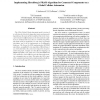Free Online Productivity Tools
i2Speak
i2Symbol
i2OCR
iTex2Img
iWeb2Print
iWeb2Shot
i2Type
iPdf2Split
iPdf2Merge
i2Bopomofo
i2Arabic
i2Style
i2Image
i2PDF
iLatex2Rtf
Sci2ools
IPPS
2007
IEEE
2007
IEEE
Implementing Hirschberg's PRAM-Algorithm for Connected Components on a Global Cellular Automaton
The GCA (Global Cellular Automata) model consists of a collection of cells which change their states synchronously depending on the states of their neighbors like in the classical CA model. In differentiation to the CA model the neighbors are not fixed and local, they are variable and global. The GCA model is applicable to a wide range of parallel algorithms, and it can be implemented on reconfigurable hardware. We discuss the GCA implementation of PRAM algorithms, exemplified by the algorithm of Hirschberg et al., which determines the connected components of a given undirected graph. Insights are that efficient mappings of PRAM algorithms onto GCA exist, and that PRAM and GCA optimality criteria differ because the latter takes memory consumption into account. This makes the GCA a parallel computational model and an implementation platform, thus narrowing the gap between theory and practice.
| Added | 03 Jun 2010 |
| Updated | 03 Jun 2010 |
| Type | Conference |
| Year | 2007 |
| Where | IPPS |
| Authors | Johannes Jendrsczok, Rolf Hoffmann, Jörg Keller |
Comments (0)

